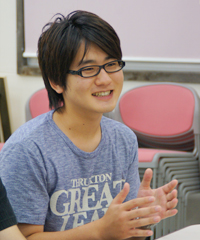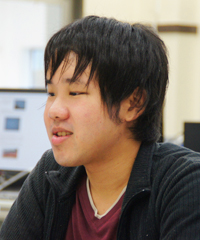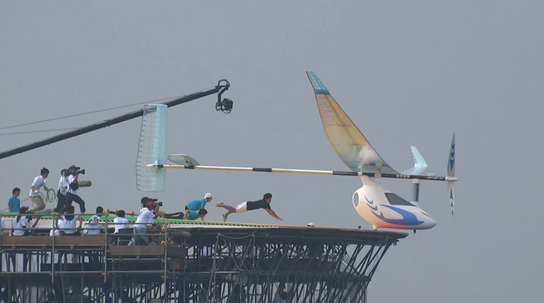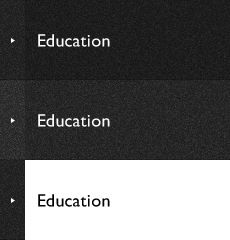Meister, one of Tokyo Tech's extracurricular clubs, won the 2013 Japan International Birdman Rally which was held on the eastern shore of Lake Biwa on July 28. The rally was broadcast by the Nippon Television Network Corporation on September 4. Meister participated in the human-powered aircraft distance rally category and won with a flight distance of 20,399 m. This was Meister's 5th victory, its last win being three years ago, and marked the 18th time the club had participated in the Japan International Birdman Rally.
The birdman rally is an event where contestants compete in flight distance and flight time with human-powered aircraft of their own construction. In the human-powered aircraft distance rally category of the Japan International Birdman Rally, pilots are pushed off by team members from a 10-meter high platform installed on the shore of Lake Biwa and travel as far as they can until their aircraft plunges into the water. Six Meister members talked about building this year's aircraft, SHO, and about the day of the rally.

In front of the Meister workshop
Interviewees holding the 1st-place certificate
Kazuhiro Kizaki, Meister Captain
3rd-Year, Department of Control and Systems Engineering, School of Engineering
Fumiya Watanabe, Designer
3rd-Year, Department of Control and Systems Engineering, School of Engineering
Keita Saito, Pilot (absent from the interview)
3rd-Year, Department of Chemistry, School of Science
Yoshiki Mori, Propeller Group Head
3rd-Year, Department of Mechanical Engineering and Science, School of Engineering
Akihiro Mihara, Propeller Group Designer
3rd-Year, Department of Information Science, School of Science
Riho Murofushi, Wing Group Designer
3rd-Year, Department of Control and Systems Engineering, School of Engineering
Akiho Obata, Wing Group
3rd-Year, Department of Mechanical and Intelligent Systems Engineering, School of Engineering
Can you give us your candid feedback on this year's flight and how it feels to have won the rally?

Kizaki, Captain
Kizaki: I feel well rewarded for having disciplined myself for one year and for having devoted myself to building the aircraft. Students can become a member of Meister from their first year, but Meister members mainly work from the summer of their second year till the following summer of their third year. About 40 members were involved in building the human-powered aircraft and worked 6 or 7 days a week. Meister capitalized on each member's strength, which led to the best outcome.
What are the characteristics of this year's aircraft?

Watanabe, Designer
Watanabe: What we were thinking about this year was to build a "pilot-friendly aircraft." The pilot takes precedence over everything else. Thanks to Meister's wealth of experience and knowledge, when it comes to building human-powered aircraft Meister usually builds extremely sophisticated aircraft in terms of performance and aerodynamics. For that reason, this year we decided to focus on things we had not paid enough attention to in the past. For example, the location of the pilot's seat is very important as only a few millimeters can make a big difference in the pilot's performance. We consulted with the owner of a bicycle shop about the location of the seat and pedals to improve this. Additionally, in cooperation with a 4th-year Meister member, we created a flight simulator for the first time. The simulator recreated the motions unique to human-powered aircraft, which helped our pilot imagine an actual flight.
How did you acquire the knowledge necessary to design and build an aircraft?
Watanabe: Unfortunately, Tokyo Tech doesn't have a department of aeronautical engineering (laughter), so I learned from books. We referred to well-known books in birdman rally circles.
Mihara: From the very beginning of the design stage, all that was expected of the Propeller Group was thrust. For the sake of realizing our performance goals, we read academic papers in the field of aerodynamics written in English.
What challenges did you encounter while building your human-powered aircraft?
Mori: How much time do we have? (Laughter.) There were many.
Murofushi: The whole point of building wings is to make them unbreakable and at the same time light. Wing Group members have always used a hand-made slicer to prepare 1.2-mm thick Styrofoam sheets. We would be up all night working, because the slicer didn't work that well.
Mori: This year the Propeller Group changed the way we made our molds. As a result, we couldn't make good molds. It was very difficult to file down the molds by hand afterwards.
Kizaki: We had to make a different number of spare parts for each part of the aircraft as they all wear out at different rates during the series of test flights which Meister conducts each year between April and the end of June. We were constantly repairing the aircraft or replacing something like the wings or the spars. We needed four plus propellers, for example. The cockpit fairing had to be repaired after each test flight.

Mori (left), Mihara (right), Propeller Group
How was the successful 20-km long flight in the 2013 Japan International Birdman Rally?

Saito, Pilot
Kizaki: The weather conditions were very good. It was cloudy and the temperature was around 30 degrees C at 9 a.m. Meister was scheduled to be the seventh aircraft to fly but we were moved up to sixth. It was perfect timing because there was a lull in the wind. Nonetheless, we experienced problems: the hand-made altimeter was malfunctioning, we lost communication with the pilot and the GPS was not working 100%. The aircraft was flying at an altitude of 1.5 m about 14 km out, whereas it normally would be flying at an altitude of 5 or 6 m.
Obata: I felt nervous because the aircraft touched the surface of the lake along the way. (Note: According to the rules, an aircraft can continue the rally if it gains altitude immediately after touching the water.)
Kizaki: We lost sight of the aircraft when it got a few kilometers out from the platform where most of the Meister members were waiting and watching. So we cheered for the pilot, Keita Saito, watching a small monitor. This year the aircraft plunged into the water during the turn. This is partly because we can't do training for turns in our test flights. The turning radius of a Meister aircraft is about 80 m, therefore it is too dangerous for an aircraft to make a turn on a runaway. I give credit to our pilot for his excellent work. He showed excellent pilotage by avoiding an island located on the route.
Watanabe: When the motorboat finally reached our pilot and the aircraft in the water, he was crying loudly. We didn't know what to say to him. He showed a lot of self-discipline by having trained enough during the previous year to be able to pedal for two hours. He didn't even get a leg cramp and felt that he could have continued to propel the aircraft if it weren't for the turn.

Preparing the aircraft on the day of the rally
Kizaki: I heard that the hardest part for the pilot was to keep a balance between strength training and endurance training in order to be able to pedal continuously for a few hours at a time. I frequently witnessed Saito pedaling an exercise bike in the workshop. He also didn't drink alcohol for a long time.
Obata: He didn't join Meister's ski trip this year either for fear of injuries.
Kizaki: After this remarkable feat, he must be relaxing now and having a good time traveling abroad. (Laughter.)
Tell us about your lives as students. How do you manage to balance your studies and activities in Meister. What about your future plans, too?
All interviewees: Studies... (Laughter.)
Kizaki: We help each other get through exams and reports. Some classes, including Mechanical and Aerospace Engineering, have lots of assignments. Fortunately, many Meister members excel in this academic field. So we have people to consult with when doing these assignments, which is an advantage of being a Meister member. All of us here will go on to various departments in the Graduate Schools. What we learned in Meister activities might not be of direct use in those departments, but our experiences will become useful sometime in the future. From my experience of being the Captain of Meister, I now find the job of organizing people interesting, and would like to assume this kind of position in the future.
Kizaki: I thought I would be very busy once I'm affiliated with a lab. However, a 4th-year student and several master's students who used to be in Meister told me, "You will never be busier than when you were a Meister member!" I know I will do fine in a lab. (Laughter.)

Obata (left), Murofushi (right), Wing Group
Third-year students are stepping back from the prominent positions in Meister now that the rally is over. How do you feel about this?
Kizaki: Staff from the Collaboration Center for Design and Manufacturing (CODAMA), 4th-year Meister members, Meister alumni and master's students, companies and many other people all cooperated with Meister, which taught me the importance of cooperation. Our activities drew on our strengths and revealed each other's good points which led to our win.
Watanabe: To be honest, I have never experienced such a leisurely summer as this. Somehow it just doesn't feel right.
Murofushi: This is a happy ending. As a 4th-year Meister member, I will send in snacks to the 1st-year friends I made in the club.
Mori: I thought about leaving Meister due to the tough nature of the work when I was a 1st-year student...
Obata: Don't talk like that, it might scare off 1st-year students. (Laughter.)
Mori: However, I started to have fun once I got used to the tough work. It is precisely for that reason that I feel happy now.
Finally, do you have any message for future Meister members?
Kizaki: For those who would like to devote themselves to something, Meister is the place to be. The Wing Group has a lot of fun doing their work. The Fairing Group contributes to a successful flight through their fluid calculations. Meister is a club for various types of people and members work together to achieve something awesome. I would like future Meister members to enjoy the process of turning ideas into reality, and enjoy the feeling of accomplishment.
Obata: Winning the Japan International Birdman Rally is just frosting on the cake, isn't it?
Watanabe: Most of all, not many people can build an aircraft which a person can actually fly.
With 3rd-year students moving on to other things after the rally, 2nd-year members will pick up the reins and play a central role in Meister. At the end of August some members stayed over on campus to begin work for the 2014 Japan International Birdman Rally. Meister's next challenge has already started.

Take-off from the platform
A Typical Year for 2nd- and 3rd-Year Meister Members (human-powered aircraft team)
The pilot undergoes intensive training over the course of the year. He/she is required to achieve the physical endurance necessary to keep pedaling for two hours nonstop and the strength to fly that year's aircraft.
| August - September |
-Design an aircraft taking into consideration the performance of the previous year's aircraft at the rally.
-Build test wings and molds for the propellers.
-Conduct stress tests on the wings.
-Perform various other tasks. |
October
- March |
-Build multiple aircraft parts for the series of test flights.
(Many parts ware out quickly or can only be used once, as noted above.) |
April
- June |
-Carry out test flights on a runaway. Test flights are normally conducted from the late-evening on Fridays till the early-morning on Saturdays. In 2013 Meister made seven test flights. |
| July |
Japan International Birdman Rally |
Links
The Special Topics component of the Tokyo Tech Website shines a spotlight on recent developments in research and education, achievements of its community members, and special events and news from the Institute.
Past features can be viewed in the Special Topics Gallery.
Published: September 2013
. Any information published on this site will be valid in relation to Science Tokyo.











